Today was supposed to be clear and cool. They got the cool part correct, but missed badly on the "clear." When I got up to check the sky before venturing out for sunrise, the entire sky was gray in all directions. Back to bed.
One of the advantages of our campsite is that we look straight up at West Temple. We know immediately what's going on in the southern section of the park by looking out our window. This morning, it showed nothing but gray all morning. We had a leisurely omelet breakfast and did some odds-and-ends cleanup.
It finally started to clear up about noon, so we made lunches and drove up toward the bridge. As we looked up the Scenic Drive and the main part of the canyon, we decided to spend the day above the tunnel in the slickrock area. The main canyon was still mostly clouds and would probably be better later in the week.
Every time we drive up through the slickrock section, I can't help but marvel at the geology. Most of the area is made up of sand dunes up to 1000 feet thick that are frozen in time as Navajo sandstone. The wind direction and history of the sand deposits are part of the puzzle displayed in the formations. Washes lined with sand and maples wind between the ridges of sandstone along much of the road to Checkerboard Mesa. We've been here when the maples are at their peak red and seem almost garish in an area of tans and whites. This year, fall color has come early and nearly every maple is stripped to skeleton.
Lacking in fall color, this year has been all about the bighorn sheep. We had only driven a few miles above the tunnel, when I saw a big ram working his way across the slickrock on a huge formation right in front of us. He was actually moving toward the road. We quickly pulled into a turnout and tried to get our long lenses on our cameras. In the meantime, the ram had just enough time to reach the wash below the formation and disappear. Carol spied a second ram farther up the formation followed by a ewe. I tried to hustle down the highway to get in front of the big ram, so he would have to come to me. Carol stayed higher on the ridge and tried to find the ram in the thicket between the road and the wash. I was sure I had gotten ahead of the ram because I didn't think he was that fast and I saw no tracks in the wash. I eventually worked my way down to the wash and hiked back toward the Explorer. I saw the ewe and followed her until she posed on a ridge for me. The ram, however, had eluded me. I walked back up to the Explorer and discovered that Carol wasn't there. That meant one thing: she had found the ram. I hiked back along the road and spotted Carol on a small knoll above the road shooting the two rams. It turned out I had gotten ahead of the rams, and they simply outsmarted me and cut behind me when I worked down to the wash. Carol got some excellent shots, and I got a few quick shots before a German couple spooked them into crossing over the ridge and out of sight.
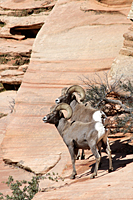 |
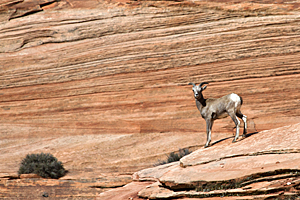 |
A couple more miles up the road, we stopped to photograph a small stream that was still running after the storm when we checked it out last night. Today, the "stream" was nothing but a narrow ravine with water standing in a couple of potholes. The shot was gone. When I reached the Explorer, a photographer returning to his car said he saw a group of bighorn right around the next corner. We grabbed our long lenses and hiked about 1/4 mile down the road until we saw cars parked and people pointing. That was a sure sign. We each found good vantage points and started photographing seven bighorn sheep on a ridge just off the road. Everyone kept their distance, and the bighorn sheep were content to hang out on the ridge. There seemed to be one general leader who may have been a very young ram. The rest were young ewes and lambs. They stayed in a very tight group and were very vigilant about looking for danger. When they decided to lie down for a siesta, they made sure there was at least one sheep facing each direction. There was no way anything was going to sneak up on them.
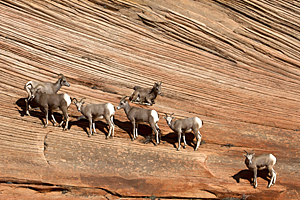
|
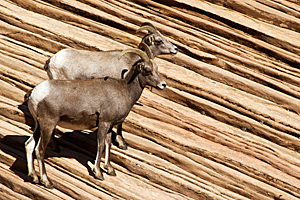
|
We continued up the road and had lunch at the Checkerboard Mesa turnout. Checkerboard Mesa towers 900 feet above the road and is one of the best examples of crossbedding you will ever see. It's companion Crazy Quilt Mesa is just east and appears even more massive than Checkerboad Mesa.
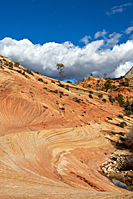 After lunch,
we returned to one of our favorite shooting areas where Pine Creek passes below a huge arch high on the sandstone wall. This year, one of the
very few bright gold cottonwoods still has its leaves along the creek. The contrast between the bright gold of the cottonwood leaves and the pink
and tan sandstone cliffs made a compelling subject. Besides the arch, this area is known for its patterns in the sandstone. This is the only area
we've seen in Zion that rivals what we saw in Valley of Fire.
After lunch,
we returned to one of our favorite shooting areas where Pine Creek passes below a huge arch high on the sandstone wall. This year, one of the
very few bright gold cottonwoods still has its leaves along the creek. The contrast between the bright gold of the cottonwood leaves and the pink
and tan sandstone cliffs made a compelling subject. Besides the arch, this area is known for its patterns in the sandstone. This is the only area
we've seen in Zion that rivals what we saw in Valley of Fire.
By 5:00, the lighting was nearly gone; a combination of clouds and ridges blocking the sun. By 5:30, we were back in camp and it wasn't even dark. That is very unusual.
Tonight was steak night and Survivor. We were only out shooting for about 4 hours today, but the bighorn sheep made it a very successful day.

